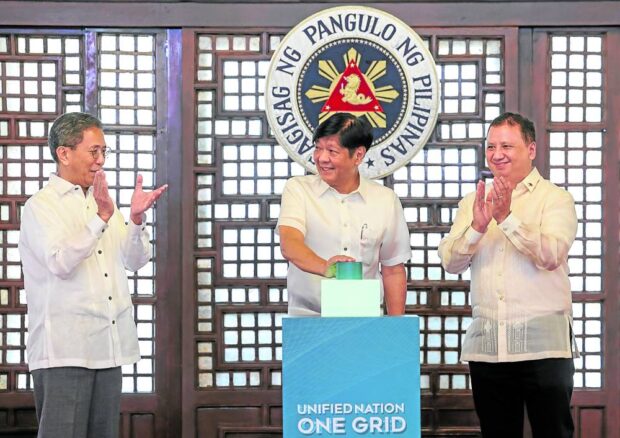
VOLT IN President Marcos (middle), Energy Secretary Raphael Lotilla (left) and NGCP president Anthony Almeda “switches on” the P51.3-billion Mindanao-Visayas Interconnection Project on Friday. —PHOTO COURTESY OF NGCP
MANILA, Philippines —After years of delays caused by the COVID-19 pandemic and legal battles, the 450-megawatt (MW) Mindanao-Visayas Interconnection Project (MVIP) finally began full commercial operations on Friday, allowing the country’s three major island groups to share power through a single transmission network.
National Grid Corp. of the Philippines (NGCP), the lone operator of the transmission backbone, said simultaneous switch-on ceremonies were held in Manila and the provinces of Cebu and Lanao del Norte to symbolize the “unification” of the Luzon, Visayas and Mindanao grids.
President Marcos witnessed the ceremony in Malacañang on Friday, the same day that the power reserve market was launched. (See related story below).
READ: PH power grid ‘highway’ online for stable supply
“This milestone is the culmination of almost 40 years of vision, studies and surveys, and, finally, construction and energization of the MVIP under NGCP. This is a testament of our dedication and commitment to fulfilling our mandate of improving, upgrading, expanding and enforcing the Philippine power grid,” NGCP president and chief executive Anthony Almeda said in his speech.
Daunting challenges
NGCP revived plans to construct MVIP in 2011 after the project was initially abandoned decades ago due to “challenges in implementation.”
In the months since it was first energized in April 2023, the P51.3-billion MVIP only ran at partial capacity because of incomplete transmission projects crucial to its full-capacity operation.
The project is comprised of a 184-circuit-kilometer high-voltage direct current submarine transmission line that connects the Visayas and Mindanao grids through the Lala Converter Station in Lanao del Norte and the Dumanjug Converter Station in Cebu.
MVIP was energized with an initial load of 22.5 MW, and capacity was gradually ramped up to reach the full 450 MW. But this could expand to as much as 900 MW, NGCP said.
READ: DOE, ERC told: Study allowing 3rd parties to construct transmission projects
NGCP has long been in hot water due to completion delays, citing logistical challenges brought about by the COVID-19 pandemic, as well as court orders halting construction in some areas.
Energy Secretary Raphael Lotilla lauded NGCP for completing the project despite challenges.
“The good news was that NGCP, despite some of the unfinished transmission lines, found ways to alleviate the stranded power situation last year,” the energy chief said.
The Energy Regulatory Commission last year flagged NGCP for 37 delayed transmission line projects, including MVIP, which was originally scheduled for completion in December 2020.
Lawmakers and the DOE also pointed out in 2023 that major power interruptions could have been prevented if the MVIP was completed on time.
For his part, Almeda said “several big-ticket projects” meant to further upgrade grid performance would be completed “in the next months.”

